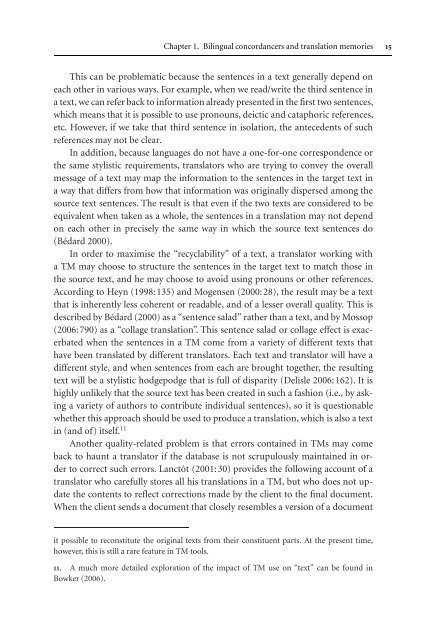Topics in Language Resources for Translation ... - ymerleksi - home
Topics in Language Resources for Translation ... - ymerleksi - home
Topics in Language Resources for Translation ... - ymerleksi - home
- No tags were found...
Create successful ePaper yourself
Turn your PDF publications into a flip-book with our unique Google optimized e-Paper software.
Chapter 1. Bil<strong>in</strong>gual concordancers and translation memories 15This can be problematic because the sentences <strong>in</strong> a text generally depend oneach other <strong>in</strong> various ways. For example, when we read/write the third sentence <strong>in</strong>a text, we can refer back to <strong>in</strong><strong>for</strong>mation already presented <strong>in</strong> the first two sentences,which means that it is possible to use pronouns, deictic and cataphoric references,etc. However, if we take that third sentence <strong>in</strong> isolation, the antecedents of suchreferences may not be clear.In addition, because languages do not have a one-<strong>for</strong>-one correspondence orthe same stylistic requirements, translators who are try<strong>in</strong>g to convey the overallmessage of a text may map the <strong>in</strong><strong>for</strong>mation to the sentences <strong>in</strong> the target text <strong>in</strong>a way that differs from how that <strong>in</strong><strong>for</strong>mation was orig<strong>in</strong>ally dispersed among thesource text sentences. The result is that even if the two texts are considered to beequivalent when taken as a whole, the sentences <strong>in</strong> a translation may not dependon each other <strong>in</strong> precisely the same way <strong>in</strong> which the source text sentences do(Bédard 2000).In order to maximise the “recyclability” of a text, a translator work<strong>in</strong>g witha TM may choose to structure the sentences <strong>in</strong> the target text to match those <strong>in</strong>the source text, and he may choose to avoid us<strong>in</strong>g pronouns or other references.Accord<strong>in</strong>g to Heyn (1998:135) and Mogensen (2000:28), the result may be a textthat is <strong>in</strong>herently less coherent or readable, and of a lesser overall quality. This isdescribed by Bédard (2000) as a “sentence salad” rather than a text, and by Mossop(2006:790) as a “collage translation”. This sentence salad or collage effect is exacerbatedwhen the sentences <strong>in</strong> a TM come from a variety of different texts thathave been translated by different translators. Each text and translator will have adifferent style, and when sentences from each are brought together, the result<strong>in</strong>gtext will be a stylistic hodgepodge that is full of disparity (Delisle 2006:162). It ishighly unlikely that the source text has been created <strong>in</strong> such a fashion (i.e., by ask<strong>in</strong>ga variety of authors to contribute <strong>in</strong>dividual sentences), so it is questionablewhether this approach should be used to produce a translation, which is also a text<strong>in</strong> (and of) itself. 11Another quality-related problem is that errors conta<strong>in</strong>ed <strong>in</strong> TMs may comeback to haunt a translator if the database is not scrupulously ma<strong>in</strong>ta<strong>in</strong>ed <strong>in</strong> orderto correct such errors. Lanctôt (2001:30) provides the follow<strong>in</strong>g account of atranslator who carefully stores all his translations <strong>in</strong> a TM, but who does not updatethe contents to reflect corrections made by the client to the f<strong>in</strong>al document.When the client sends a document that closely resembles a version of a documentit possible to reconstitute the orig<strong>in</strong>al texts from their constituent parts. At the present time,however, this is still a rare feature <strong>in</strong> TM tools.11. A much more detailed exploration of the impact of TM use on “text” can be found <strong>in</strong>Bowker (2006).
















